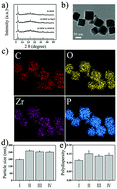Mitochondria-targeted zirconium metal–organic frameworks for enhancing the efficacy of microwave thermal therapy against tumors†
Abstract
Although microwave (MW) thermal therapy has been widely studied for the treatment of tumors due to its less invasiveness, recurrence of tumors is still observed because of the relatively low bioavailability of MW sensitizers. For enhancing the bioavailability of MW sensitizers, triphenyl phosphate (TPP)-conjugated and doxorubicin (DOX)-loaded porous zirconium metal–organic framework nanocubes (ZrMOF NCs) modified with polyethylene glycol (PEG), ZrMOF-PEG-TPP@DOX NCs, were prepared as a MW sensitizer with mitochondrial-targeting ability. Moreover, the mitochondria are more susceptible to heat than the tumor tissues; this leads to improved tumor cell apoptosis. The results of this study indicate that ZrMOF NCs exhibit excellent heating effects due to the increased collisions of ions in the micropores of ZrMOFs under MW irradiation. In addition, ZrMOF-PEG-TPP@DOX NCs show preferential aggregation in the mitochondria, confirmed by confocal microscopy images. In vivo MW thermal therapeutic efficacy of ZrMOF-PEG-TPP@DOX NCs + MW is also better without recurrence during treatment than that of ZrMOF-PEG@DOX NCs + MW at a similar thermal therapeutic temperature; this reveals that the mitochondrial-targeting strategy can enhance the MW thermal therapeutic efficacy. This study provides a new biosafe MW sensitizer with mitochondrial-targeting ability for enhancing the efficacy of MW thermal therapy against tumors.



 Please wait while we load your content...
Please wait while we load your content...